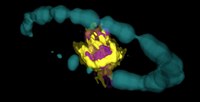Probing Molecules in Supernova Remnants
Most massive stars end their lives in core-collapse supernova (SN) explosions and enrich the interstellar medium with explosively nucleosynthesized elements. Following core collapse, the explosion is subject to instabilities as the shock propagates outward through the progenitor star. Observations of the composition and structure of the innermost regions of a core-collapse supernova provide a direct probe of the instabilities and nucleosynthetic products. SN 1987A in the Large Magellanic Cloud is one of very few supernovae for which the inner ejecta can be spatially resolved but are not yet strongly affected by interaction with the surroundings.
F.J. Abellán (Universidad de Valencia) and his colleagues analyze ALMA observations of SN 1987A acquired that are the highest resolution to date and that reveal the detailed morphology of cold molecular gas in the innermost regions of the remnant. The 3D distributions of carbon and silicon monoxide (CO and SiO) emission differ, but both have a central deficit, or torus-like distribution, possibly a result of radioactive heating during the first weeks. The size scales of the clumpy distribution are compared quantitatively to models, demonstrating how progenitor and explosion physics can be constrained.
M. Matsuura (Cardiff University, University College London) et al. report the first molecular line survey of SN87A at millimeter wavelengths. ALMA detected cold (20–170 K) CO, 28SiO, HCO+ and SO, with weaker lines of 29SiO from ejecta, the first identification of HCO+and SO in a young supernova remnant. A dip in the J = 6–5 and 5–4 SiO line profiles suggests that the ejecta morphology is elongated. The CO and SiO line profile differences are consistent with hydrodynamic simulations, which show that Rayleigh–Taylor instabilities cause mixing of gas, with heavier elements much more disturbed, making more elongated structure. Low 29Si and 30Si abundances are consistent with nucleosynthesis models that show inefficient formation of neutron-rich isotopes in a low-metallicity environment, such as the Large Magellanic Cloud. The deduced large mass of HCO+ (∼5 × 10−6 M⊙) and small SiS mass (<6 × 10−5 M⊙) might be explained by some mixing of elements immediately after the explosion. The mixing might have caused some hydrogen from the envelope to sink into carbon- and oxygen-rich zones after the explosion, enabling the formation of a substantial mass of HCO+. Oxygen atoms may have penetrated into silicon and sulphur zones, suppressing formation of SiS.
Image: Remnant of Supernova 1987A as seen by ALMA. Purple area indicates emission from SiO molecules. Yellow area is emission from CO molecules. The blue ring is Hubble data that has been artificially expanded into 3-D. Credit: ALMA (ESO/NAOJ/NRAO); R. Indebetouw; NASA/ESA Hubble.
Publications: F.J. Abellán (Universidad de Valencia) et al. Very Deep inside the SN 1987A Core Ejecta: Molecular Structures Seen in 3D, 2017, Astrophysical Journal Letters, 842, L24.
M. Matsuura (Cardiff University, University College London) et al., ALMA spectral survey of Supernova 1987A – molecular inventory, chemistry, dynamics and explosive nucleosynthesis, 2017, Monthly Notices of the Royal Astronomical Society, 469, 3347.





Connect with NRAO